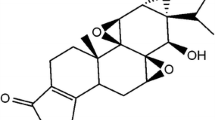Abstract
Dithiocarb and (+)-cyanidanol-3 prevented paracetamol-induced liver injury in rats in vivo. Both, as well as two other antihepatotoxic agents, deanol and DMSO, inhibited covalent binding of [3H]-paracetamol to rat liver microsomal proteins in vitro. Dithiocarb and (+)-cyanidanol-3 were the most effective inhibitors. The concentrations of the antidotes yielding 50% inhibition (I50) valued 1 · 8 × 10−5 M for dithiocarb and 2 · 1 × 10−5 M for (+)-cyanidanol-3.
Similar content being viewed by others
References
Bray GA (1960) A simple efficient liquid scintillator for counting solutions in a liquid scintillation counter. Anal Biochem 1:279–185
Jollow DJ, Mitchell JR, Potter WZ, Davis DC, Gillette JR, Brodie BB (1973) Acetaminophen-induced hepatic necrosis. II. Role of covalent binding in vivo. J Pharmacol Exp Ther 187:195–202
Kappus H, Bolt HM, Remmer H (1973) Irreversible protein binding of metabolites of ethinylestradiol in vivo and in vitro. Steroids 22:203–225
Kappus H, Bolt HM, Buchter A, Bolt W (1976) Liver microsomal uptake of 14C-vinyl chloride and transformation to protein alkylating metabolites in vitro. Toxicol Appl Pharmacol 37:461–471
McLean AEM, Nuttall L (1978) An in vitro model of liver injury using paracetamol treatment of liver slices and prevention of injury by some antioxidants. Biochem Pharmacol 27:425–430
McMurtry RJ, Snodgrass WR, Mitchell JR (1978) Renal necrosis, glutathione depletion, and covalent binding after acetaminophen. Toxicol Appl Pharmacol 46:87–100
Mitchell JR, Jollow DJ, Potter WZ, Davis DC, Gillette JR, Brodie BB (1973) Acetaminophen-induced hepatic necrosis. I. Role of drug metabolism. J Pharmacol Exp Ther 187:185–194
Mudge GH, Gemborys MW, Duggin GG (1978) Covalent binding of metabolites of acetaminophen to kidney protein and depletion of renal glutathione. J Pharmacol Exp Ther 206:218–226
Potter WZ, Davis DC, Mitchell JR, Jollow DJ, Gillette JR, Brodie BB (1973) Acetaminophen-induced hepatic necrosis. III. Cytochrome P-450-mediated covalent binding in vitro. J Pharmacol Exp Ther 187:203–210
Remmer H, Greim H, Schenkman JB, Estabrook RW (1967) Methods for the elevation of hepatic microsomal mixed function oxidase levels and cytochrome P-450. Methods Enzymol 10:703–708
Siegers C-P (1976) Vergleichende Untersuchungen zur antihepatotoxischen Wirkung von Diäthyldithiocarbamat (Dithiocarb) und anderen Thioverbindungen. Habilitationsschrift, Lübeck
Siegers C-P (1978) Antidotal effects of dimethyl sulfoxide against paracetamol-, bromobenzene-, and thioacetamide-induced hepatotoxicity. J Pharm Pharmacol 30:375–377
Siegers C-P, Younes M (1979) Einfluß von 2-Dimethylaminoethanol auf die hepatotoxischen Wirkungen von Paracetamol bei Ratten und Mäusen. Drug Res 29:520–523
Siegers C-P, Strubelt O, Völpel M (1978a) The antihepatotoxic activity of dithiocarb as compared with six other thio compounds in mice. Arch Toxicol 41:79–88
Siegers C-P, Filser JG, Bolt HM (1978b) Effect of dithiocarb on metabolism and covalent binding of carbon tetrachloride. Toxicol Appl Pharmacol 46:709–716
Strubelt O, Siegers C-P, Schütt, Atsuko (1974) The curative effects of cysteamine, cysteine and dithiocarb in experimental paracetamol poisoning. Arch Toxicol 33:55–64
Younes M, Pentz R, Oltmanns D (1979) Inhibitory and stimulatory effects on the metabolic disposition of paracetamol. Naunyn-Schmiedebergs Arch Pharmacol 307 Suppl R 7
Younes M, Siegers C-P, Filser JG (1979) Effect of dithiocarb and dimethyl sulfoxide on irreversible binding of 14C-bromobenzene to rat liver microsomal protein. Arch Toxicol 42:289–293
Author information
Authors and Affiliations
Rights and permissions
About this article
Cite this article
Younes, M., Siegers, C.P. Inhibition of the hepatotoxicity of paracetamol and its irreversible binding to rat liver microsomal protein. Arch. Toxicol. 45, 61–65 (1980). https://doi.org/10.1007/BF00303296
Received:
Issue Date:
DOI: https://doi.org/10.1007/BF00303296




